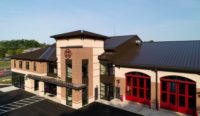Local Architecture Flavor Adorns Fire Station




The Captiva Island Fire Control District had two mandates for the construction of its new fire station; blend into the architecture of the historic district, and be strong enough to withstand hurricanes. Located in Lee County, Fla., the barrier island is just offshore in the sparkling waters of the Gulf of Mexico. The island has historically been impacted by several hurricanes.
Architectural design for the new, modern 9,000-square-foot station was created by Sweet Sparkman Architects in Sarasota. The design aesthetic is based on the island’s cottage style of residential buildings—some dating back to the early 1900s. From a practical standpoint, the building is constructed to be a hurricane command center able to withstand winds up to 170 miles per hour, which is above Miami-Dade code requirements.
“The challenge was to create a rather large two-story structure in context with the vernacular of the immediate neighborhood, which has lots of charming cottages,” said Todd Sweet, founder and principal of Sweet Sparkman Architects. “The design team sought to back down the scale of the new station with materials and volumes so the station would fit in with the architecture of the island. The Fire Control District was very concerned about being contextual and respectful of the environment.”
The design called for approximately 7,000 square-feet of PAC-CLAD Tite-Loc Plus panels to be utilized on two pitched roofs. The .032-inch aluminum panels were finished in Petersen Cool Color Silver.
“It was a priority to use metal on the roof,” Sweet said. “We do a lot of coastal work, and aluminum stands up better to the harsh saltwater environment. Aluminum is always a good choice of material for a roof that needs to meet hurricane impact loading requirements and be resilient to the environment, too.”
While the new station is built to meet the latest hurricane standards, it also achieved its design aesthetics goal and has been warmly welcomed to the neighborhood. “A lot of fire stations tend to be pretty utilitarian but this one has many nice treatments and details that make it special,” Sweet said. “For example, the sunshades, overhangs and trellises really relate to the ‘cottage-like’ feel of the neighborhood, although, the treatments are made of metal which is obviously much more durable than traditional wood.”
The PAC-CLAD Tite-Loc Plus panels used on the roof are the “Cadillac of panels” in terms of strength and durability, said Royal Casey, Petersen’s architectural sales rep covering central and south Florida. “And aluminum is clearly best for saltwater. Our use of stainless steel clips and fasteners is also standard for best performance in these coastal conditions.”
Installation of the Tite-Loc Plus panels was completed by Saint Raphael Roofing in Fort Myers, Fla. The Petersen distributor on the project was ABC Supply.
For more information on the complete line of Petersen metal products, or visit pac-clad.com.
Looking for a reprint of this article?
From high-res PDFs to custom plaques, order your copy today!







